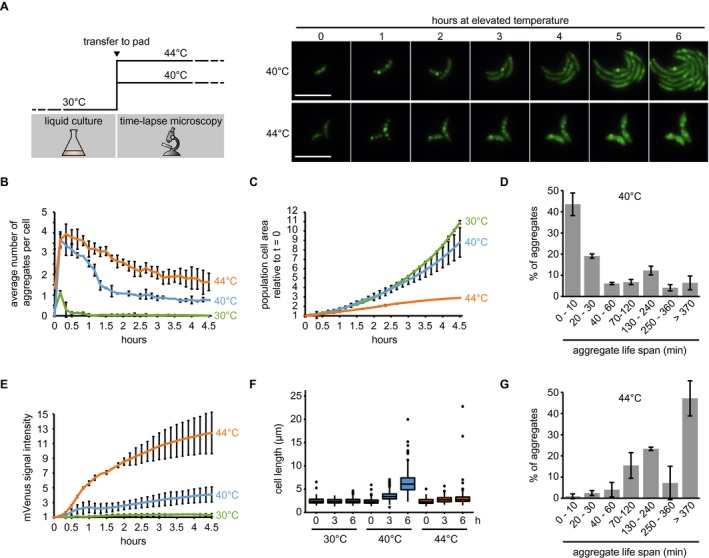Figure 4.

Growth and protein aggregation dynamics during sustained heat stress. A. Schematic of upshift experiments (left), and representative images following upshift to 40°C or 44°C over a 6 h period. Scale bar is 5 µm. B. Quantifications of fluorescence time‐lapse microscopy images showing the average number of aggregates per cell over time in cell populations continuously grown at 30, 40 and 44°C. Note that after transfer to 30°C a minor fraction of dim and short‐lived DnaK‐mVenus foci formed. C. Total cell area increase during exposure to 30, 40 or 44°C relative to the first time point (t = 0). Quantifications in (B, C) show the means of biological triplicates for which at least eight microcolonies each were analyzed. Error bars represent standard deviations. D. Quantification of aggregate life span in cells continuously exposed to 40°C. Aggregates present or emerging in the first 300 min of a fluorescence time‐lapse movie were tracked until 400 min. Images were acquired every 10 min. Quantifications show the means of biological triplicates for which at least five microcolonies and 89 aggregates each were analyzed. Error bars represent standard deviations. E. DnaK‐mVenus fluorescence intensity per total bacterial area over time in cells grown at 30, 40 or 44°C normalized to the first time point (t = 0). The same cells as in (B, C) were quantified. F. Quantification of population cell lengths after 0, 3 and 6 h continuous exposure to 30, 40 or 44°C. The cell lengths of two biological replicates were pooled and populations representing at least 504 measurements are shown. G. Quantification of aggregate life span in cells continuously exposed to 44°C. Aggregates present at 0 min were tracked until 480 min (new aggregates did not arise). Images were acquired every 10 min. Quantifications show the means of biological duplicates for which at least 14 microcolonies and 63 aggregates each were analyzed. Error bars represent standard deviations.
